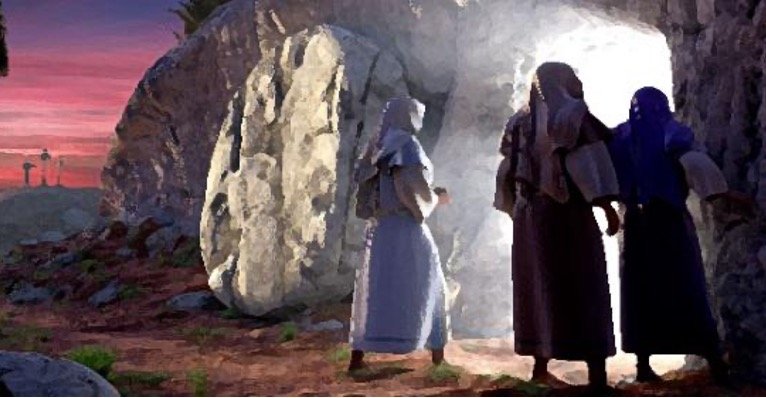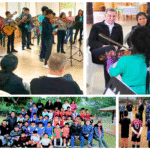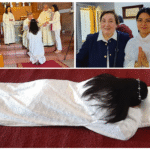
Gospel according to Saint Luke 24,35-48:
The disciples told what had happened on the road and how Jesus made himself known when he broke bread with them. As they went on talking about this, Jesus himself stood in their midst. And he said to them, «Peace to you». In their panic and fright they thought they were seeing a ghost, but he said to them, «Why are you upset and why do such ideas cross your mind? Look at my hands and feet and see that it is I myself. Touch me and see for yourselves that a ghost has no flesh and bones as I have». As he said this, He showed his hands and feet. In their joy they didn’t dare believe and were still astonished. So He said to them, «Have you anything to eat?», and they gave him a piece of broiled fish. He took it and ate it before them.
Then Jesus said to them, «Remember the words I spoke to you when I was still with you: ‘Everything written about me in the Law of Moses, the Prophets and the Psalms had to be fulfilled’». Then He opened their minds to understand the Scriptures. And He went on, «You see what was written: the Messiah had to suffer and on the third day rise from the dead. Then repentance and forgiveness in his name would be proclaimed to all the nations, beginning from Jerusalem. Now you shall be witnesses to this».
Emmaus: more than a singular episode
Luis CASASUS President of the Idente Missionaries
Rome, April 14, 2024 | III Sunday of Easter
Acts 3:13-15.17-19; 1Jn 2:1-5; Lk 24:35-48
Death and life, seen through new eyes. A European doctor had traveled to Tanzania to work in a hospital at the foot of Mount Kilimanjaro; he was eager to see this famous mountain, the highest in Africa. But when he arrived at his destination, the sky was cloudy and the mountains were hidden behind thick white clouds.
Finally, on the fourth day, the sky cleared and he searched for the mountain, but still could not see it. In the end, he realized that his focus was wrong: in his little world, the mountain peaks that looked big are seen where the clouds begin. But Kilimanjaro rises nearly six kilometers into the sky, and although he was staring at the snow-covered peak, he couldn’t see it. He thought he was looking at the huge, bulky white image of clouds. But when his eyes finally adjusted to this new reality, the sheer size and majesty of the mountain took his breath away.
That’s the way we look. It is like when we pick an apple from a tree. It is not that we reject all the others, but we are fully focused on that apple, to make sure that there is no wasp on top of it and that its condition is good to taste it with pleasure. That is our “selective attention”.
Perhaps the two disciples walking to Emmaus were so focused on their grief, on what they considered the failure of their dreams, that they were slow to recognize this traveler who spoke to them and set their hearts on fire.
From this surprising episode, we should learn something important about our relationship with Christ: How am I not able to notice his presence in the deepest impressions that move me every day?
When I meet someone who comforts or troubles me.
When at some point I have betrayed what seems to me to be true, beautiful, generous.
When an event is so violent, painful or unexpected that it causes confusion in my mind and in my mood.
These are not “individual” experiences; Christ walks with me on these occasions, He tries to tell me the meaning of all the events, of all the experiences I see in my life and in the lives of those around me. He wants to turn what seems most negative, closest to death, into life, a life that is also contagious.
The disciples of Emmaus were trying to find meaning in their lives after a tragic and desolate event. Their journey to Emmaus must have seemed to them like a walk in the desert, in the darkness of death, where hope had evaporated.
Jesus’ death on the cross was the culmination of all contradictions and evil, for if there was to be a solution and an end to our despair, it would be in the hands of the Savior God had sent us. But as far as the disciples are concerned, He is dead. And if our Savior is dead, then there is no hope.
The reason this story resonates with so many of us is because we have also been, in some way, in that dark place, walking, shuffling through the valley of death and tears. That is the condition of humanity, unable to find hope when it has not encountered the Risen Christ. But his Resurrection becomes ours; I see that in my life the Holy Spirit works changes that can well be called resurrection, new life. As St. Paul said, a new creation:
Therefore, if anyone is in Christ, he is a new creation; old things have passed away, now they have become new (2Co 5: 17).
—ooOoo—
A well-known novel told the story of a wealthy woman who traveled around the world, visiting museums and art galleries, meeting people and seeing the sights. Soon she became completely bored with it all. Then she met a man who possessed none of the world’s goods, but a great love of beauty and a sincere appreciation for it. In his company, everything seemed totally different to her. At one point, she told him: I never knew what things were like until you taught me how to look at them. In every love story there comes a time when the lover says that to the beloved.
In today’s First Reading, we see how Peter proposes to the Israelites facing the resurrection a different way of looking at Christ. And, of course, Jesus teaches the disciples of Emmaus to contemplate the whole Passion and the Cross in a new way: as something necessary for glorification (cf. Lk 24: 25-27). The text is taken from Peter’s discourse after healing a paralytic in the Temple. In the disciples, the change has been so great that it leads the witnesses to ask themselves: who are these men? As the Second Reading says, the actions, the faithfulness of the true disciple, make him a credible witness.
The intimate relationship with Christ is quite a discovery, something unexpected, especially a way of receiving mercy and the possibility of giving it in the same way. It is really another way of contemplating mercy, about which most of us have a poor idea, limited to a feeling of compassion or empathy. The moving story of The Hunchback of Notre Dame, Victor Hugo’s famous novel, comes to mind.
Quasimodo, a man with a deformed face, hunchbacked, one-eyed and lame, falls in love with Esmeralda, who does not reciprocate his love. Esmeralda is a strikingly beautiful woman, while Quasimodo is a deformed man, but his love for Esmeralda is not mere physical attraction. Esmeralda is the only person who has shown human kindness to the hunchback; she brings him water when he is dying of thirst after being publicly whipped and humiliated. In fact, Esmeralda so fully captivates his heart that, when she is hanged for a crime she has not committed, he goes to the cemetery, embraces her body and never leaves it until he dies of starvation.
In the celebration of the Eucharist, we commemorate precisely what happens to the disciples of Emmaus: they meet Christ and are immediately sent and impelled to invite everyone to meet Him. This is witnessing.
This was very well done by a little girl from New York, who was asked by one of our brothers, who was her catechist, what, in his opinion, was the most important part of the Mass. Without batting an eye, the girl replied: Go in peace, the Mass is over. At first, the catechist thought that the girl was joking, but she was totally serious and meant exactly what she had said.
This missionary took the opportunity to explain that, indeed, the purpose of the Mass is to nourish us spiritually: first, with the Word of God in the Liturgy of the Word, and second, with the Life of God in the Liturgy of the Eucharist. And God feeds us so that we can go out and give testimony of Him with our life, our words and our actions. The missionary added: The Eucharist does not end with the Concluding Rite. On the contrary, it begins there. Like the two disciples of Emmaus, we must go out and tell others what the Lord Jesus has done in us.
In our littleness, as happened to the first disciples, the power of the resurrection is made visible (Phil 3:10), without the need for us to work wonders. It is curious that, after walking several miles with Jesus, they recognized him in a small detail, not in anything spectacular: his way of breaking the bread, which, with him and for us, becomes a sacrament.
—ooOoo—
All of us have the desire to tell our stories. We feel the need to share our experiences with others. Parents like to share the stories of their lives with their children. They tell them what they went through and how they experienced their joys and their sorrows, their struggles and their accomplishments. We all need to share our stories with someone, because we want others to share our sorrows, our sufferings, our joys and our successes.
So, storytelling is part of the process of being human. By telling them, we feel understood, appreciated, empathized with and strengthened. Even more so when we are hurt and wounded. Telling our stories to our good friends, counselors or spiritually sensitive people is a necessary part of the healing process. In addition, the simple act of articulating our concerns, fears and anxieties helps us crystallize the basis and scope of those concerns. Jesus responds to this inclination by instituting the Sacrament of Reconciliation.
This is what happened to the Emmaus disciples. They too had their story to tell, a deeply spiritual story. They had been through difficult times. Jesus, whom they called their teacher, was a man they loved deeply. They witnessed his compassion for the poor and suffering, his mercy toward sinners, his passionate love for his Father and his obedience in doing his will. He preached with authority, unlike the scribes and Pharisees. He performed miracles of healing, and even demonstrated his power over nature. He multiplied five loaves of bread for more than 5000 people… For all that he did, he aroused the jealousy of the religious leaders. In conspiracy among themselves, they instigated the crowd to go against Jesus and finally put him to a cruel and unjust death on the cross. They were stunned and confused by the sad end. This is what Peter said: This man, who was put in your power by the deliberate intention and foreknowledge of God, was seized and crucified by men who were not of the law. You killed him. The disciples of Emmaus echoed the same sentiments.
It is in the communion of the Body and Blood of Christ that He gives Himself fully to them. It is in the communion of this broken Body that they can truly meet the risen Christ. Then he can disappear from the sight of the disciples.
Let us pray today that, as the privileged ones that we are, we will always recognize him in the breaking of the bread and the sharing of his Body and Blood.
_______________________________
In the Sacred Hearts of Jesus, Mary and Joseph,
Luis CASASUS
President













